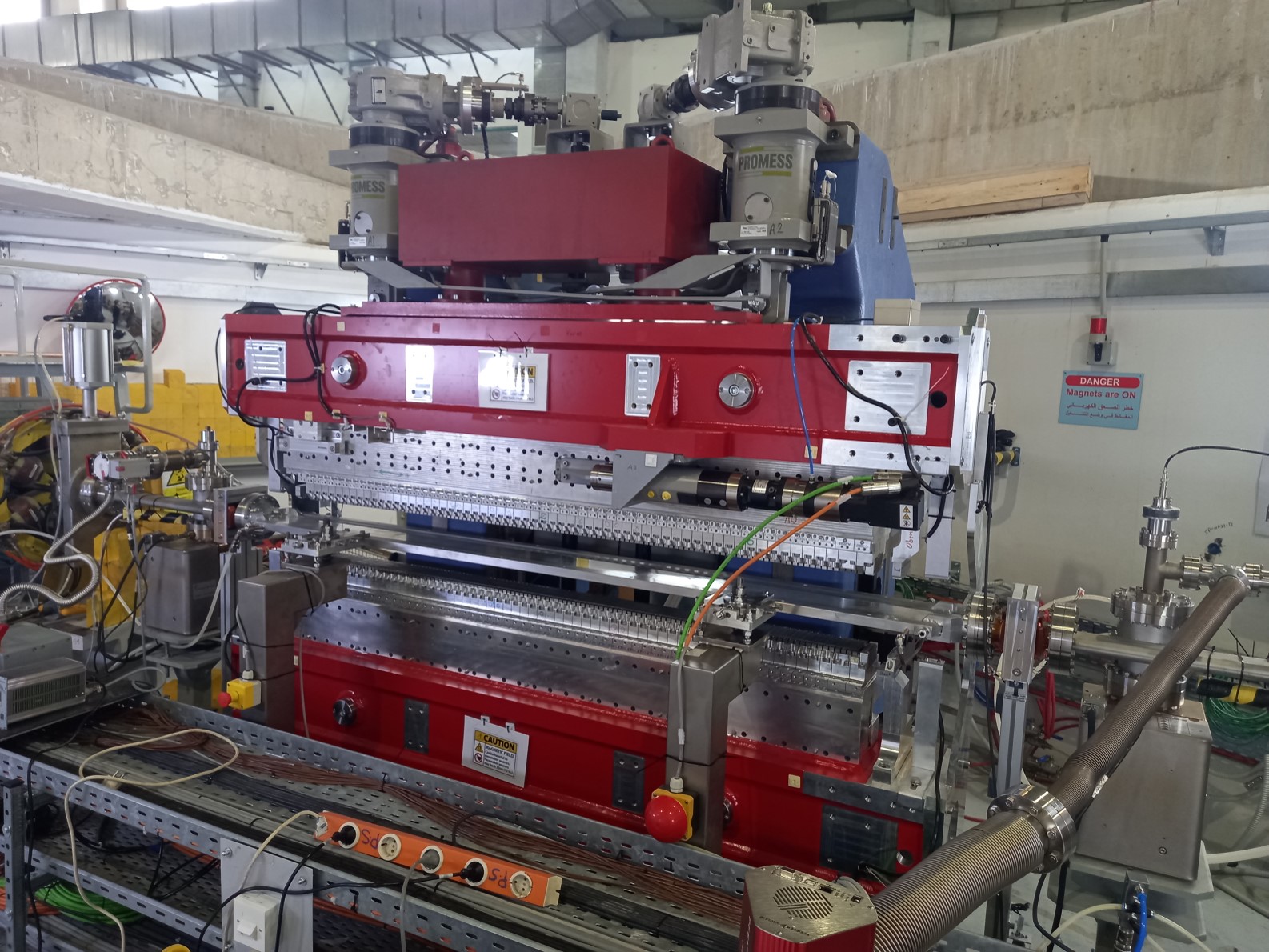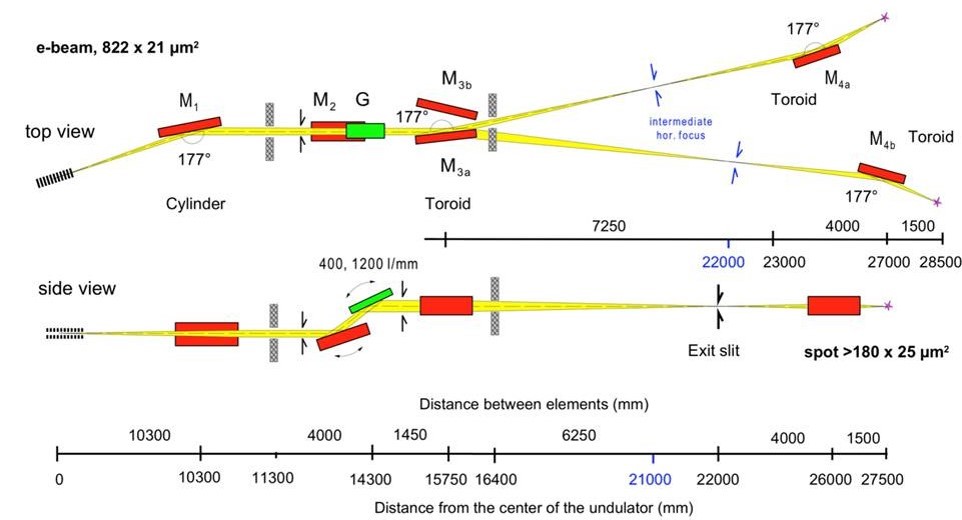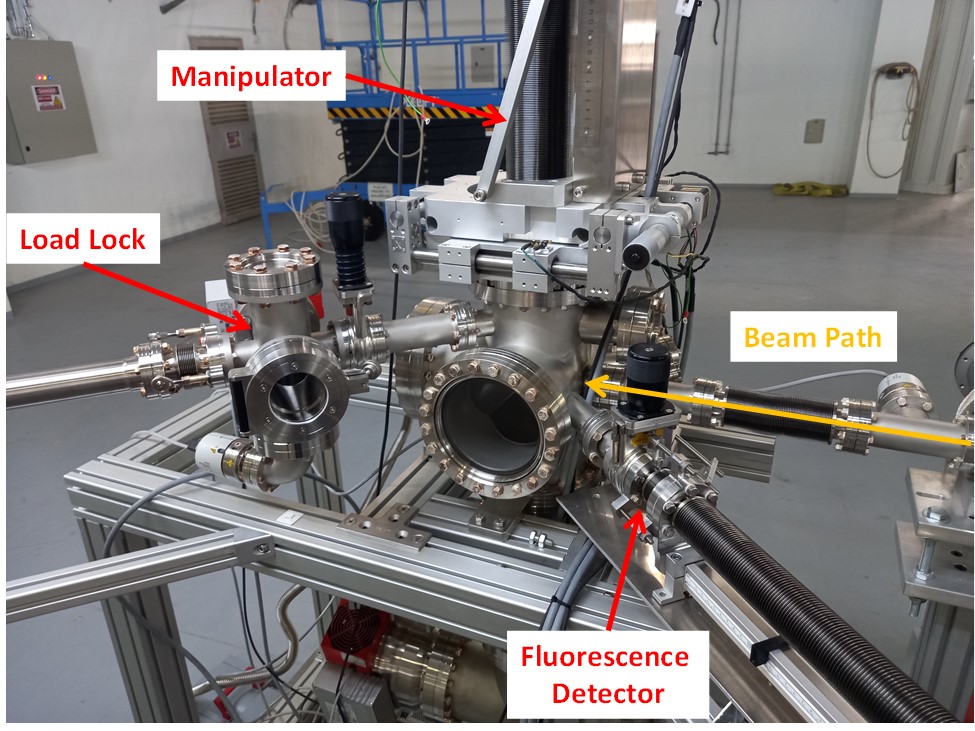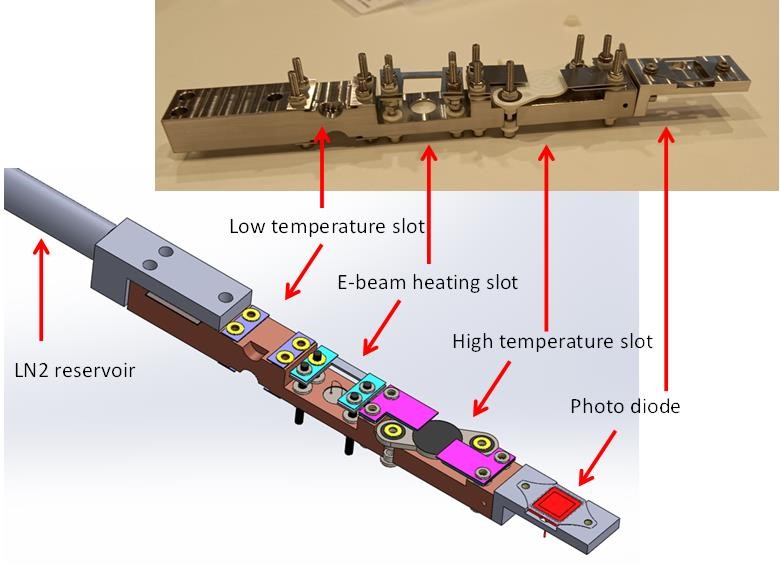
HElmholtz-SESAME Beamline (HESEB) is the first soft X-ray beamline at SESAME. The HESEB project was set up by the Helmholtz Association of German Research Centers. Five Research Centers of the Association (DESY, FZJ, HZB, HZDR, KIT) took charge of the design, construction, installation, and commissioning of the beamline, with DESY taking the lead in the project.
The HESEB beamline was designed to range the photon energies from about 70 eV to 1800 eV. An Apple II type Undulator is used as the photon source, and a Plane Grating Monochromator (PGM) is used as the photon dispersing tool. In addition, the beamline contains a beam splitter unit placed just after the PGM that has made it possible to build a second branch that can work in the same photon range interchangeably as the ID11-right branch. This has now been exploited by the ID11R-TXPES (Turkish soft X-ray PhotoElectron Spectroscopy) beamline. The HESEB analysis chamber contains a fluorescence detector and can make total electron yield measurements with a motorized manipulator.
Soft X-ray analysis techniques are mainly used to understand the atoms' electronic structure and chemical environment. Soft X-ray techniques are surface-sensitive because soft X-rays have a high interaction probability with matters. In the case of hard X-ray spectroscopy techniques, soft X-ray analysis can be applied to low atomic number elements that are critical for life and advanced sciences, such as Carbon Nitrogen and Oxygen.
The ID11L-HESEB beamline was inaugurated on 12 June 2022. It started hosting users in February 2024.
Photon Source
HESEB Beamline is using an UE56 Apple II type Undulator. The length of the undulator is 1.7 m with 30 period of 56 mm length each. Minimum gap of the undulator magnets are 12.8 mm. so the undulator can produce photons with ~70 eV energy. The undulator has also capability to produce circularly polarized soft X Ray photons for Circular Dichroism studies.

Beamline Optics
You can see the layout of the HESEB beamline in Figure 2. The total available length from the center of the straight section to the focal spot at the experiment was set at 27.5 m for branch line A and 28.5 m for the second branch line B. Branch A is going to be equipped with an experimental chamber for absorption (electron/fluorescence yield) spectroscopy. The second branch (B) is foreseen for a photoemission (XPS) experimental station planned by a consortium of scientists from Turkey. This is still in production stage. The name of the beamline is TXPES (Turkish soft X-ray PhotoElectron Spectroscopy).

The first cylindrical mirror (M1) is located inside the shield wall deflecting the beam horizontally, collimating it vertically and forming a horizontal focus as indicated. The monochromator has a plane mirror (M2) and two interchangeable plane gratings with 400 l/mm and 1200 l/mm groove density. The ultimate energy resolution is about 10,000 for the 400 l/mm grating and 20,000 for the 1200 l/mm grating. The dispersed beam is offset by 15 mm vertically from the original beam.
The toroid M3 focuses the beam onto the exit slit. Finally, a refocusing toroidal mirror (M4) images the exit slit onto the sample position, creating a focal spot of 180 x 25 μm2. This spot size is largely determined by the source size of the beam in the undulator. In order to accommodate the power load of the undispersed beam, M1, M2 and the gratings are water cooled by side cooling. In regular operation, e.g. M1 absorbs 170 W of 200 W incident power.
Experimental Station (End Station)
Absorption coefficient of Soft X-ray photons is so high that the soft X ray measurements have to be done under vacuum. The HESEB End station is and Ultra high Vacuum chamber. With the help of load-lock system, the sample changes can be done in 45 minutes. The picture of the HESEB end station and components are shown in the figure 3.

The end station has motorized manipulator arm so that 2D mapping can be done. There are 3 different slot on the receptacle part of the manipulator; 1) low temperature slot 2) e-beam heating slot, 3) High temperature slot in addition to these slot there is a photo diode for diagnostic purposes. Because of the sample transfer system a special holder is used. The maximum sample can be 15x15 mm2. In figure 4 you can see the drawing and picture of the receptacle part.

Technical information about the HESEB Analyze Chamber:
- three slots on the receptacle part
- calculated spot size on the sample 180x25(hxv)µm2
- the size of the sample holder 15x15 mm2
- samples can be cooled with LN2 down to -180 °C
- samples can be heated up with a button heater up to 900 °C
- motorized manipulator, 1µm repeatable spatial resolution
- analyze capabilities under He at the low vacuum medium
- Keithley 8485 picoammeter for electron yield measurement
- Bruker XFlash 630S detector for fluorescence yield measurement
UE56-SESAME
Planer Grating Monochromator
1200 grove/mm
HESEB End Station
Keithley 8485 picoammeter for electron yield measurement
Sample
Manipulator or Sample stage
Sample Holders
Fluorescence Detector
Detection
Picoammeter
Detection
- Sample Type: Crystal, Amorphous, Powder, Thin Film.
2025 (2), 2023 (1), 2022 (2), All (5)
2025
- TXPES A new soft X-ray spectroscopy beamline at the SESAME synchrotron,
Journal: Journal of Physics: Conference Series,
Vol. 3010 - 1, pp. 012023-012024 (2025)
E. Ozensoy, S. Kaya, A. Aksoy, G. Gundogdu, O. Kantoglu, B. Yildirimdemir, Z.R. Ozturk, M.F. Genisel, M.A. Najdawi, A. Lausi, F. Lehner, W. Eberhardt, W. Drube, R. Follath
doi: 10.1088/1742-6596/3010/1/012023 - HESEB Soft X-ray Beamline ID11-L at SESAME: Performance and First User Experiments,
Journal: Journal of Physics: Conference Series,
Vol. 3010 - 1, pp. 012043-012043 (2025)
A Abbadi, M Al Najdawi, M Alzubi, M Attal, W Drube, W Eberhardt, FM Esser, R Follath, MF Genisel, D Gorbunov, D Groetsch, S Hammouda, AR Hasoneh, E Huttel, O Krueger, A Lausi, F Lehner, A Meseck, Y Momani, ZR Ozturk, E Rial, M Roschka, M Scheer, B Schramm, S Schuppler, M Shehab, H Soltner, C Tiemann
doi: 10.1088/1742-6596/3010/1/012043
- Control System for HESEB Beamline at SESAME,
Journal: tajminger, Ana (2023)
A. Abbadi, M. Abugharbiyeh, A. Al-Dalleh, A. Aljadaa, M. Alzubi, M.F. Genisel, R. Khrais, S. Matalgah, Y. Momani
doi: 10.18429/JACoW-PCaPAC2022-THP02
- SESAME Gets Soft X-Ray Beamline HESEB,
Journal: Synchrotron Radiation News,
Vol. 35 - 1, pp. 22-22 (2022)
W Drube, MF Genisel, A Lausi
doi: 10.1080/08940886.2022.2043710 - HESEB: The Helmholtz state-of-the-art Soft-X-Ray Undulator beamline at SESAME,
Journal: Journal of Physics: Conference Series,
Vol. 2380 - 1, pp. 012036-012036 (2022)
A Abbadi, M Attal, W Drube, W Eberhardt, F Martin Esser, R Follath, M Fatih Genisel, A Rahman Hasoneh, M Huck, E Huttel, B Kanngiesser, S Knaack, O Krueger, A Lausi, F Lehner, M Lörgen, A Meseck, Y Momani, M Al Najdawi, G Paolucci
doi: 10.1088/1742-6596/2380/1/012036
Mustafa GENISEL
HESEB Beamline Scientist
Email: Mustafa.Genisel@sesame.org.jo
Work Tel: +962 5 351 1348 (Ext. 367)
Ahlam FARHAN
HESEB Beamline Post-doc
Email: ahlam.farhan@sesame.org.jo
Work Tel: +962 5 351 1348 (Ext. 367)

